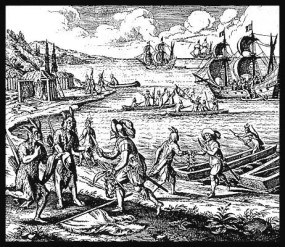
Matthäus Merian, Dreyzehender Theil Americae, 1628 The Colombian ExchangeThere was little contact between the people of the Americas and the people of Europe before the 1400s; but, after more and more European explorers ventured out to the Americas, a mass migration began. However, this land was already populated with many different indigenous tribes who had been living on this land for centuries. When the native tribes of the Americas and the explorers and settlers of Europe came into contact with one another, a cataclysmic exchange between the Americas and Europe began. This historical swap of culture, ideas, diseases, plants, animals, people, metals, and technology is known as the Columbian Exchange. 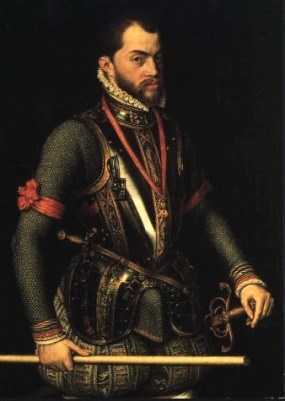
Alonso Sánchez Coello, 1566 Spain EmergesReligious and political conflict consumed medieval Spain. Unification came at the end of the 15th century which was the start of the modern Spanish Empire that controlled, influenced, or claimed nearly half of the world through the 16th-18th centuries. Regionally, Spanish influence began with the exploration of La Florida by Ponce de Leon in 1513 and continued with the settlement of St. Augustine, established by Pedro Menendez in 1565. The construction of Castillo de San Marcos began in 1672. The Spanish FlagThe flag which flies over Castillo de San Marcos and Fort Matanzas is described in heraldry as a red saltire raguly on a white field. A saltire is an X figure; raguly refers to the jagged edges of the cross. The X-shaped cross is commonly called "St. Andrew's cross," because tradition says that Andrew the Disciple was crucified on a cross of that shape. The story is that the branches were roughly hacked off two small trees, and the trees were tied together to make the cross. The jagged edges of the cross on the Spanish flag represent these trees with the branched lopped off. Since the flags of Ireland and Scotland (and the flag of Great Britain incorporating the cross of Scotland) are also St. Andrew's crosses, when speaking of the Spanish flag, this design is best called the Burgundian Cross, or the Cross of Burgundy. 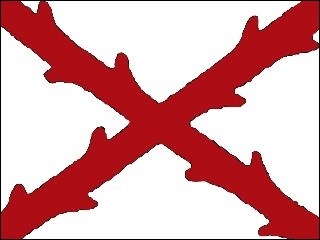
Queen Isabella and King Ferdinand, who sponsored Columbus' voyages to the New World, used the medieval flag with the red and gold quartered lions and castles, which represented the united Spain of Leon and Castile. However, since they did not have a son to succeed them, the Spanish Crown went to the son of their oldest daughter, Juana, who was married to Philip, Duke of Burgundy. The red saltire was his family symbol, since Andrew was the patron saint of Burgundy. White was the distinctive color of French Royalty, and Burgundy was a French state. In 1506, Philip came to rule Spain as Philip I, regent to his young son Charles. Charles also adopted this flag when he became Charles I of Spain (1516-1556). He was also Charles V of the Holy Roman Empire, probably the most powerful man in Europe at that time. 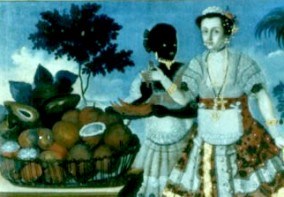
Vicente Alban; Quito, Ecuador, 1783 Colonial CultureThe culture that emerged in the colony of La Florida was a blend of Spanish, local Native, and African customs. “Latinized” America was a diverse, often complex society. While Spanish colonies continuously sought to duplicate the traditional Spanish way of life of Europe, through actions like instituting the Roman Catholic Church in their settlements; the colonies ended up carving out their own unique traditions, identities, and cuisines in the Americas. Click here to learn more about American Latino Heritage in National Parks. 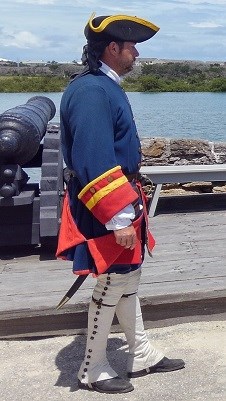
NPS The Spanish SoldierWhen we look at the soldiers (soldados) of Spanish St. Augustine, we see a multicultural, gallant group of men. They may have traveled from Europe or were from the Americas. The often mixed – European, Native American, and African – ancestry of these Spanish soldiers is the beginning of the diverse American society we know today. These highly-skilled, trained troops served in many different capacities and ultimately protected St. Augustine from foreign encroachment through the course of two major sieges and many other conflicts. What would life be like in Spanish St. Augustine, a fairly bustling town of approximately 1,700 people in the middle of the eighteenth century? What would be the experience of its residents? Read More About The Spanish Soldier... |
Last updated: April 20, 2022
